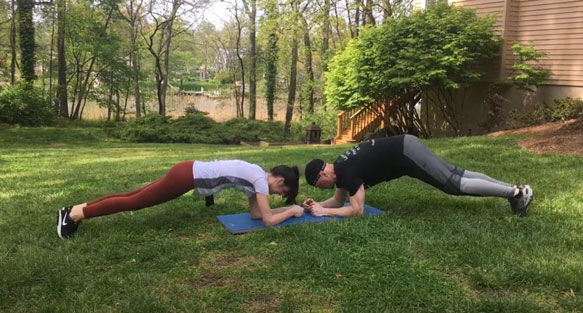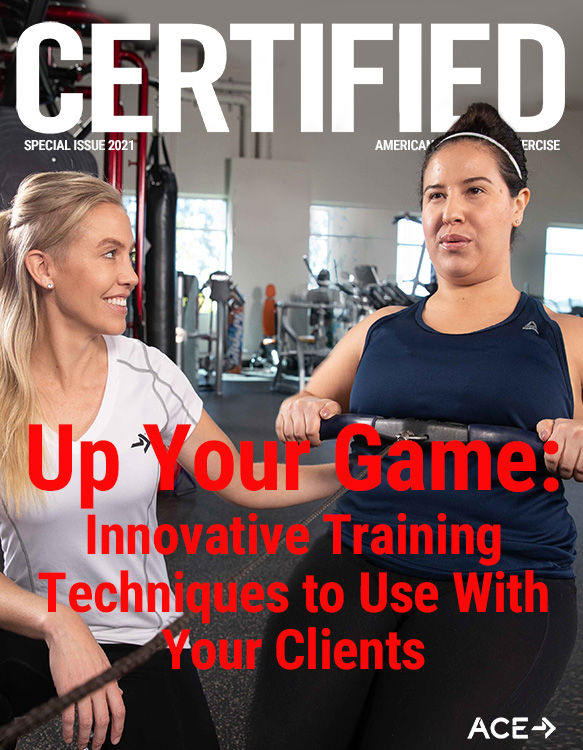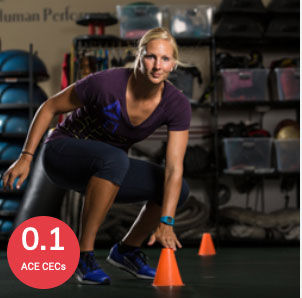
While clients rarely cite better agility as a primary fitness goal, agility is actually pretty essential, not only to be able to move well, but also to successfully perform many sports-related skills. Additionally, movements that target agility often make exercise more engaging and appealing, while also minimizing age-related declines in motor neurons, thus preventing sarcopenia and frailty.
Ready for Anything
Agility is the ability to rapidly alter ongoing motor patterns to handle the unpredictable and unexpected movement requirements of life and sport more effectively. The ability to produce an appropriate physical response to the sudden movement of an opponent or teammate in sport or to the slip of your foot on ice or a wet floor are equally important, although more attention is generally paid to the former rather than the latter. For many clients, however, being able to respond quickly to something like a wet floor can mean the difference between continued good health and injury.
Integrated Agility Training
A study in Sports Medicine focusing on older adults looked specifically at the effect of incorporating agility training with other modalities of fitness. The researchers made the following conclusions:
- Enhanced endurance can attenuate fatigue-induced declines in postural control in sports-related or general activities of daily living.
- It is inefficient and prohibitively time-consuming to separately develop other modalities such as balance, strength and endurance. Further, doing so may impede integrative training of the sensorimotor, neuromuscular and cardiocirculatory functions required to deal with balance-threatening situations in seniors.
The researchers recommended that agility training should be integrated into the other major modalities commonly associated with exercise. It is worth examining, however, the researchers’ first point regarding fatigue-induced declines in postural control. Years ago, I heard the phrase: “Fatigue makes amateurs of us all.” In other words, even if people posses a high degree of skill, fatigue can render them less coordinated, powerful and successful in their physical responses. This is an important consideration when designing integrated training programs for your clients.
Fall Prevention
Falling is of increasing concern to people as they age, with research confirming that the incidence of falls increases with each decade of life. However, the better an individual’s neuromuscular system is at sensing what is happening and producing an appropriate physical response (reactivity and agility), the less likely he or she is to have a trip that results in a fall.
Why does aging increase the likelihood of falling? Motor unit remodeling is one reason. A motor unit consists of a motor neuron and all the muscle fibers it controls. While fast-twitch fibers are more prone to hypertrophy and fatigue more quickly, slow-twitch fibers tend to be smaller and fatigue resistant. With age, fast-twitch neurons tend to die off first. To prevent atrophy, a slow-twitch neuron will attach itself to the abandoned muscle fibers, resulting in a slow-twitch neuron controlling actions previously under the direction of a fast-twitch neuron. The result? Precise movements such as balance, running and stepping your foot out rapidly to just the right place to prevent a fall now become slower and less coordinated.
The Remedy for an Agility Deficiency
With inactivity, individuals will typically experience a 3−8% loss of muscle mass per decade after the age of 30. However, exercise that challenges fast-twitch muscle fibers by producing fast, powerful, strong and precise movements can prevent much of the age-related decline in muscle mass, strength and function. Further, most agility exercises are enjoyable, fun and interactive if performed with one or more people—all of which are important for enhancing adherence and promoting consistent participation.
The following agility-focused workout was created using the ACE Integrated Fitness Training® (ACE IFT®) Model as a guide. This workout also incorporates balance, coordination, endurance, strength and power, and the exercises can be performed solo or with a partner.
The workout features movements that incorporate more than one of the five primary movement patterns featured in the ACE IFT Model (see box). The ACE IFT Model provides a framework for muscular training where we develop postural stability and kinetic chain mobility as appropriate in a specific area of the body, integrate it into a full-body movement and add external load, creating a stimulus for strength gains and increasing movement speed to develop bodily control.
Five Primary Movement Patterns
- Bend-and-lift movements: A bilateral hip- or glute-dominant movement (e.g., squat or deadlift)
- Single-leg movements: A unilateral or asymmetrical lower-body movement (e.g., single-leg squat or lunge)
- Pushing movements: A vertical or horizontal pushing movement, either bilateral or unilateral
- Pulling movements: A vertical or horizontal pulling movement, either bilateral or unilateral
- Rotational movements: A limb, torso or whole-body axial rotation
Agility is often a full-body experience as there are typically multiple body segments involved with numerous areas of stability and mobility. Postural stability is a prerequisite for successful mobility, especially when moving multiple body segments. Isolated stability and mobility training is a feature of Functional Training exercises. Therefore, the integrated mobility exercises in this workout encompass Movement Training and Load/Speed Training.
This workout integrates agility training with cardiorespiratory training, as proposed by the researchers of the study cited earlier. Options also are provided for performing the workout with one or more additional people; performing the workout with others introduces elements of reactivity, enhances enjoyment and may offer additional cognitive benefits.
The Workout
The workout features four Giant Sets, each consisting of three exercises. Perform each exercise within a Giant Set for 30 seconds of work followed by 30 seconds of rest. After completing each Giant Set three times, perform the corresponding Combined Cardio-agility exercise for one minute followed by one minute of rest before beginning the next Giant Set.
There are two tables below. The first table is for individual workouts, while the second is for partner workouts and includes the addition of reactive elements.
Adjust the amount of rest between sets Giant Sets according to your client’s/participants’ needs based on conditioning level and training goals. The objective is to provide a sufficient challenge while allowing for successful performance. The individual needs of the client or his or her chosen sports or activities may dictate using more rest (e.g., there is a greater need for precision in movement) or less rest (e.g., there is a greater need for exposing the body to functioning at a high level while fatigued).
For clients who are well-conditioned and seek a greater cardiorespiratory challenge, consider performing the Combined Cardio-agility exercises as part of the Giant Sets (i.e., complete these exercises three times each).
Over time, consider changing up the order of the exercises to enable your clients to experience the effect of doing specific exercises at various levels of fatigue. For example, if your client is performing this workout twice per week, you could change the starting Giant Set each week so that in week 2 you begin with Giant Set 2 and so on in successive weeks.
For the two exercises featuring a kettlebell, a water bottle can be used as a substitute. While the load will of course be lower, the timing and the pattern of movement will be the same. If cones are unavailable, use a towel, water bottle, keys, cell phone—whatever is on hand mark the spot.

Solo Workout
* Unidirectional means always keeping the eyes and head pointed forward; moving directional focus means the entire body is pointed in the direction you are moving

Partner Workout
Partner versions of these exercises involve altering the movement based on following the movement or commands of a partner. The “leader” directs the movement by providing verbal commands, as appropriate. Switch leader and follower roles with each repeat of the Giant Set (i.e., one person is the leader for three exercises and then switch). Partner instructions, when needed, are noted in parentheses.
* The numbers 1-2-3-4 represent the left hand, right hand, left foot and right foot, respectively. For enhanced brain challenge, periodically mix this up. For example, the odd numbers could be for the hands (left for 1, right for 3) and the even numbers for the feet (left for 2, right for 4).
+ Perform the squat while maintaining the same staggered foot position with opposite arm reach until “switch” is called.





 by
by 







